







Virginia Farm Bureau



Va. dairy farmers provide streamlined supply of milk


Volume 18, Number 2 Spring 2025
Cultivate (USPS 025051) (ISSN 1946-8121) is published four times a year. February, May, August, October. It is published by Virginia Farm Bureau Federation, 12580 West Creek Parkway, Richmond, VA 23238. Periodicals postage rate is paid at Richmond, VA and additional mailing offices. The annual Subscription Rate is $1.13 (included in membership dues).
Postmaster: Please send changes of address to, Cultivate, Virginia Farm Bureau Federation, P.O. Box 27552, Richmond, VA 23261; fax 804-290-1096. Editorial and business offices are located at 12580 West Creek Parkway, Richmond, VA 23238. Telephone 804-290-1000, fax 804-290-1096. Email address is Cultivate@vafb.com. Office hours are 8 a.m. to 4:30 p.m., Monday through Friday.
Discover some time-tested methods for keeping unwanted bugs out of your garden.
Fireworks can be fun, but learn the rules around lighting them, and find out which ones are legal.
Spring brings farm equipment out on
Find out how dairy cow
People raise chickens for many reasons—eggs, meat, pest control or backyard entertainment.
“We’re producing more milk on fewer farms.”
— ERIC PAULSON, executive director, Virginia State Dairymen's Association
All advertising is accepted subject to the publisher’s approval. Advertisers must assume liability for the content of their advertising. The publisher assumes no liability for products or services advertised. The publisher maintains the right to cancel advertising for nonpayment or reader complaints about services or products.
Member: Virginia Press Association
EDITORIAL TEAM
Pam Wiley Vice President, Communications Kathy Dixon Managing Editor
Nicole Zema Sr. Staff Writer/Photographer
Christina Amano Dolan Staff Writer/ Photographer
Kenny Kane Graphic Design Manager
Eleanor Stickley Sr. Graphic Designer Alice Kemp Sr. Staff Writer/Advertising Coordinator
MEMBERS — Address change? If your address or phone number has changed, or is about to change, contact your county Farm Bureau. They will update your membership and subscription information.
Associate members will receive their next issue of Cultivate in August. The magazine is published quarterly, and back issues can be viewed at issuu.com/virginiafarmbureau












That’s the average number of gallons of milk one Virginia dairy cow produces each day. Seerelatedarticleonpage16.





Featured this month on Real Virginia, Virginia Farm Bureau’s weekly television program:
• Learn about the factors driving record beef prices.
• Discover how land labs offer students practical, hands-on lessons about agriculture.
• Explore Amelia County’s agricultural diversity in this month’s county close-up.
Real Virginia airs nationwide at 5 p.m. on the first and third Saturdays of each month in the Voices of Agriculture program on RFD-TV on Dish Network and DirecTV; and on selected cable outlets around the state. It airs weekly on WBRA digital channel 15.2, the WHRO World Channel, WVVA Bluefield and WTKR Norfolk, and on the first and third Sundays of each month at 10 a.m. on WVIR Charlottesville and at 10:30 a.m. on WHSV Harrisonburg; and on the first and third Saturdays at 8 a.m. on WRLH Richmond and at 5:30 a.m. on WSLS Roanoke.
Bureau members receive a $500 Exclusive Cash Reward toward an eligible new F-150® Lightning®, Super Duty®, F-150, Ranger® or Maverick®





*Visit FordRecognizesU.com/FarmBureau today for complete offer details!


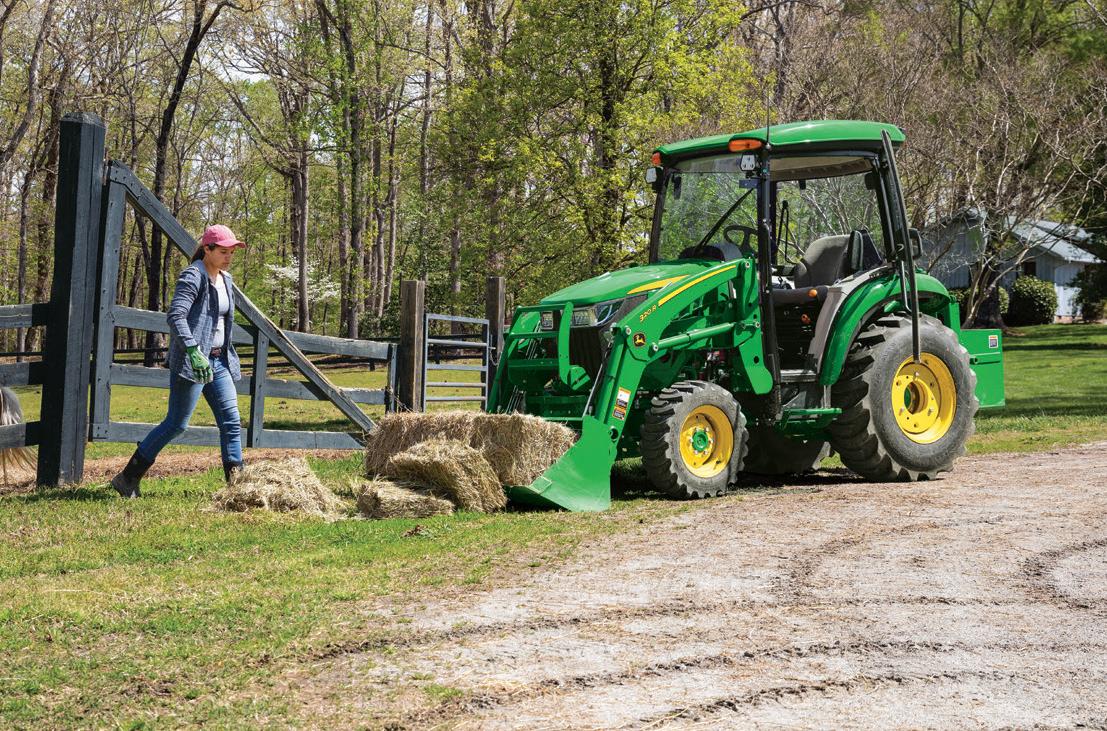
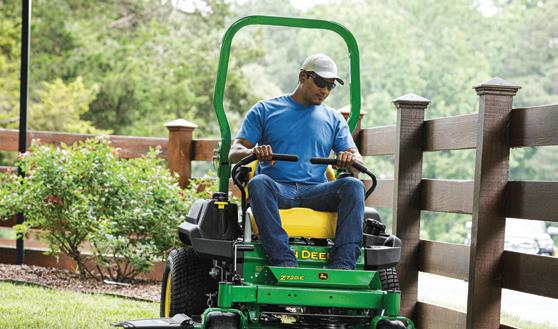





























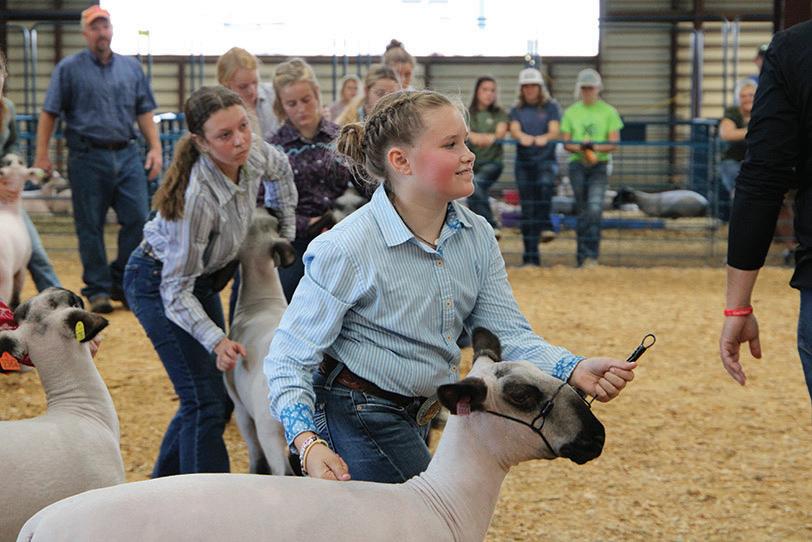


As of May 1, there are 148 days until the 2025 State Fair of Virginia opens on Sept. 26 and runs through Oct. 5.
Fair fact: The 2024 fair hosted more than 4,500 exhibitors and drew nearly 10,000 entries in competitions for livestock, vocational and technical education, visual and culinary arts, horticulture and more. Additionally, since 2013, the State Fair of Virginia has awarded over $1 million in scholarships to support youth education.
This year’s fair theme is “Real Fun, Real Virginia,” showcasing all that makes Virginia special. From thrilling rides to live entertainment to deeprooted traditions, everything people love about the commonwealth is rolled into one great occasion.
The 10-day event will host a range of attractions, artisan crafts, shopping and delicious fair food—all while celebrating Virginia agriculture. Families can look forward to a plethora of new activities,



including new strolling acts, an exciting K-9 flying disc dog show and AgriGolf—an agriculture-themed miniature golf course.
Also new this year is “Sunsets at the State Fair,” a fundraising event during which guests can enjoy an evening of mingling, drinks and light hors d'oeuvres at historic Meadow Hall. Proceeds from the nightly ticketed event will directly benefit the fair’s scholarship program.
Crowd-pleasing favorites will return, including dazzling performances by Triple Crown Circus, the World Championship Blacksmiths competition, two nights of Revenge Roughstock Rodeo and the speedy swine of Rosaire’s Royal Racers.
An array of musical performances spanning genres will take the stage during this year’s Main Stage Concert series. Each evening will feature a different artist, and concerts are included in fair admission.


The fair continues to offer ample learning opportunities for exploring Virginia agriculture and forestry. Fairgoers can explore the popular Young MacDonald’s Farm exhibit on the north side of the fair near Kidway, watch a variety of livestock and equine exhibitions and competitions in the Equine & Livestock Complex, and make discoveries in the Natural Resources Area.
And it wouldn’t be a state fair without gigantic pumpkins, squashes and watermelons on display to amaze fairgoers. Virginia artisans also will showcase award-winning handmade creations.
Want your own chance to earn blue ribbon bragging rights in fair competitions this fall? Now is the perfect time to brainstorm and practice what you’d like to bake, cook, craft, grow or raise! The fair’s 2025 competition guidelines will be available this summer at StateFairVa.org



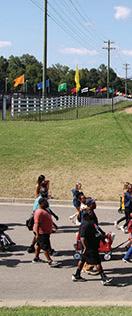

Left: A row cover is placed over plantings to keep insects away. A ladybug feeds on aphids that can damage a plant. Inspecting plants often helps to prevent infestation.
“Any insecticide is last resort,” Day noted. “Make sure you’ve tried out everything else before you go that route, because you don’t want to end up spraying on a calendar basis.”
Limiting spraying reduces impacts on pollinators, beneficial insects and the environment.
Things to consider
“If your plants aren’t doing very well, investigate all the possibilities of what could be causing that kind of damage,” Day advised. “It could be an insect issue, plant disease, not enough water or too much water.”
Placing crushed eggshells, hydrated limes or cups of beer near plants can be effective in deterring slugs, but gardeners should approach other home remedies with caution.
“Make sure that remedy isn’t going to be more damaging to the plant than it is to the pest,” he warned.
Do NOT use homemade insecticidal soap solutions, as they can be toxic to plants. Go with the commercial chemical or organic product that is specifically labeled for your plant; follow the label’s re-entry intervals to avoid contaminating the environment, applying the wrong treatment, or harvesting something with insecticides.
Keep an eye out for the emerging allium leafminer, a small gray or black fly with a yellow head that infests alliums like onions, garlic and chives.
Gardeners also may encounter the invasive hybrid fire ant as it spreads to more areas of Virginia—posing safety concerns. Contact your local Extension office to report any sightings.
“There’s always going to be pests out there, but it’s never a reason to stop gardening,” Day encouraged. “Some years will be better than others. Just keep planting, growing and enjoying!”




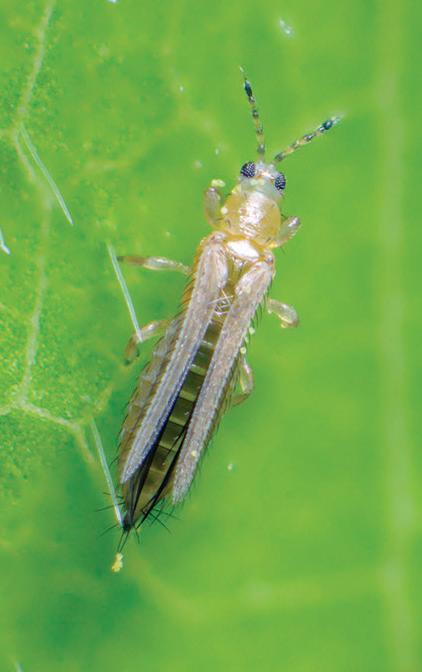
Description: Small, soft-bodied insects; about 2.54 millimeters long; green, black, gray, brown, pink, red, yellow or lavender
Targets: Beans, cabbage, carrots, cucurbits, greens or leaf crops, lettuce, okra, onion, pea, pepper, potato, strawberry
Damage: Aphids remove plant sap; cause yellowing, stunting and puckering of leaves; and leave clear sticky honeydew on plants that allows black sooty mold to grow
Control methods: Treat using a registered insecticide and follow label instructions
Description: Adults: orange with black spots, yellow and black-striped wings; larvae: reddish, black spots; yellow egg clusters
Targets: Potatoes
Damage: Larvae chew away leaves until only midribs and stems are left; heavily damaged plants are completely defoliated and have poor potato set
When to spot: Adults lay eggs on plants shortly after sprouting
Control methods: Hand pick, and drop in soapy water for small populations; use Bacillus thuringiensis var. San Diego and Bacillus thuringiensis var. tenebrionis; time application of neem or cryolite to coincide with peak egg hatch and small larvae activity; Spinosad against larvae and adult
Description: Larvae: 1 inch maximum length; orange-brown head; brown, green, pink, yellow or black body
Targets: sweet corn, tomatoes, beans, broccoli, cabbage, pepper and lettuce plants
When to spot: Abundant during late summer/early fall
Control methods: Treat using a registered insecticide, and follow label instructions
Description: Adults: copper with black spots on backs, oval-shaped, quarterinch long; larvae: orange to yellow, fuzzy or spiny, up to ⅓ inch long
Targets: beans, lima beans
Damage: These pests feed on pods and on undersides of leaves; pods and leaves are skeletonized
When to spot: Damaging populations emerge in late June to early July and can continue through the growing season
Control methods: Clean up plant debris after harvest; plant in early spring to avoid peak pest activity; use natural enemies like assassin bugs; treat with a registered insecticide when damage first appears, and spray underside of leaves.
Description: Bright yellow, difficult to spot. Adults: about 1/25 inch long; immatures: wingless, smaller
Targets: onion, beans, beet, carrot, cabbage, cauliflower, celery, cucumber, melons, peas, squash, tomato and turnip
Damage: Thrips feed inside buds, causing distorted and damaged leaves and vegetables and white blotches on leaves; tips of leaves wither and turn brown
When to spot: Adults and immature nymphs overwinter in plant debris in or near fields, then fly to gardens in early summer and lay eggs on buds and leaves. They can grow from egg to adult in 3-4 weeks
Control methods: Select thrip-resistant varieties of sweet corn; treat with a registered insecticide when damage appears or when insects appear in damaging numbers; repeat as needed and follow label instructions





Kids waving sparklers in the night as they glow like shooting stars is a familiar, lighthearted scene during festivities.
But these innocent-looking sticks are packing heat.
“Sparklers burn around 2,000 degrees, and it’s a small thin wire that could cause injury,” Jones cautioned.
That’s as hot as a blowtorch, and enough to melt some metals—and ignite clothing. In 2023, sparklers alone accounted for 700 emergency room visits. The National Fire Protection Association reports that sparklers cause nearly half of all estimated firework injuries among children under 5 years old.
Large swaths of open land and distant neighbors might seem like an ideal location to set off fireworks, but rural areas come with their own risks.
“Be aware of your surroundings,” advised Matt Nuckols, Virginia Farm Bureau Farm Safety Advisory Committee chair. “There might be grass pastures or valuable cropland like corn and wheat nearby that could quickly catch fire.”
Before lighting fireworks in the countryside, check weather conditions and check for any burn bans. If the ground is dry or it’s a blustery day, it’s best to reschedule. Never light fireworks near baled hay or stored feed, which emits natural gases that can quickly combust with a spark.
Fireworks also can have unintended consequences for nearby farms and livestock.
“Like dogs, livestock can be spooked by fireworks,” Nuckols explained. “Some farmers work with their animals even at night, and spooked livestock create situations that can injure themselves or farmers working with them. They can run through fences, knock each other down or injure a farmer.”
For a list of legal fireworks and distributors in Virginia, visit bit.ly/3FccHFj
For detailed statewide firework regulations, visit the Virginia Department of Fire Programs website at bit.ly/41BuCN4
Check with local government ordinances for firework regulations in your locality.
Before you celebrate with fireworks, be sure to:
• Consider visiting a public fireworks display instead of igniting your own. Or use safe alternatives like party poppers, bubbles, silly string or glow sticks.
• Know local fireworks laws, and only purchase legal fireworks from licensed dealers.
• Don’t experiment with homemade fireworks.
• Never allow young children to handle fireworks. Older children should be closely supervised by an adult.
• Never light fireworks indoors.
• Keep a bucket of water or hose handy in case of fire or other mishap.
• Soak spent, unused and/or malfunctioning fireworks in water for a few hours before discarding.
• Light fireworks one at a time, then move quickly away.
• Never try relighting or handling malfunctioning fireworks.
• Never place any part of your body directly over a firework when lighting the fuse.
• Never point or throw fireworks, including sparklers, at anyone.
Slow and steady wins the race, the old adage goes.
But driving down the road behind a piece of farming equipment is not a race. In fact, slow and cautious could save a life.
“If you can’t see a farmer, then they can’t see you,” noted Matt Nuckols, chair of the Virginia Farm Bureau Farm Safety Program. “And besides, it’s illegal to pass on a roadway with a double solid line—even if the driver ahead of you is going extremely slow.”






BY KATHY DIXON
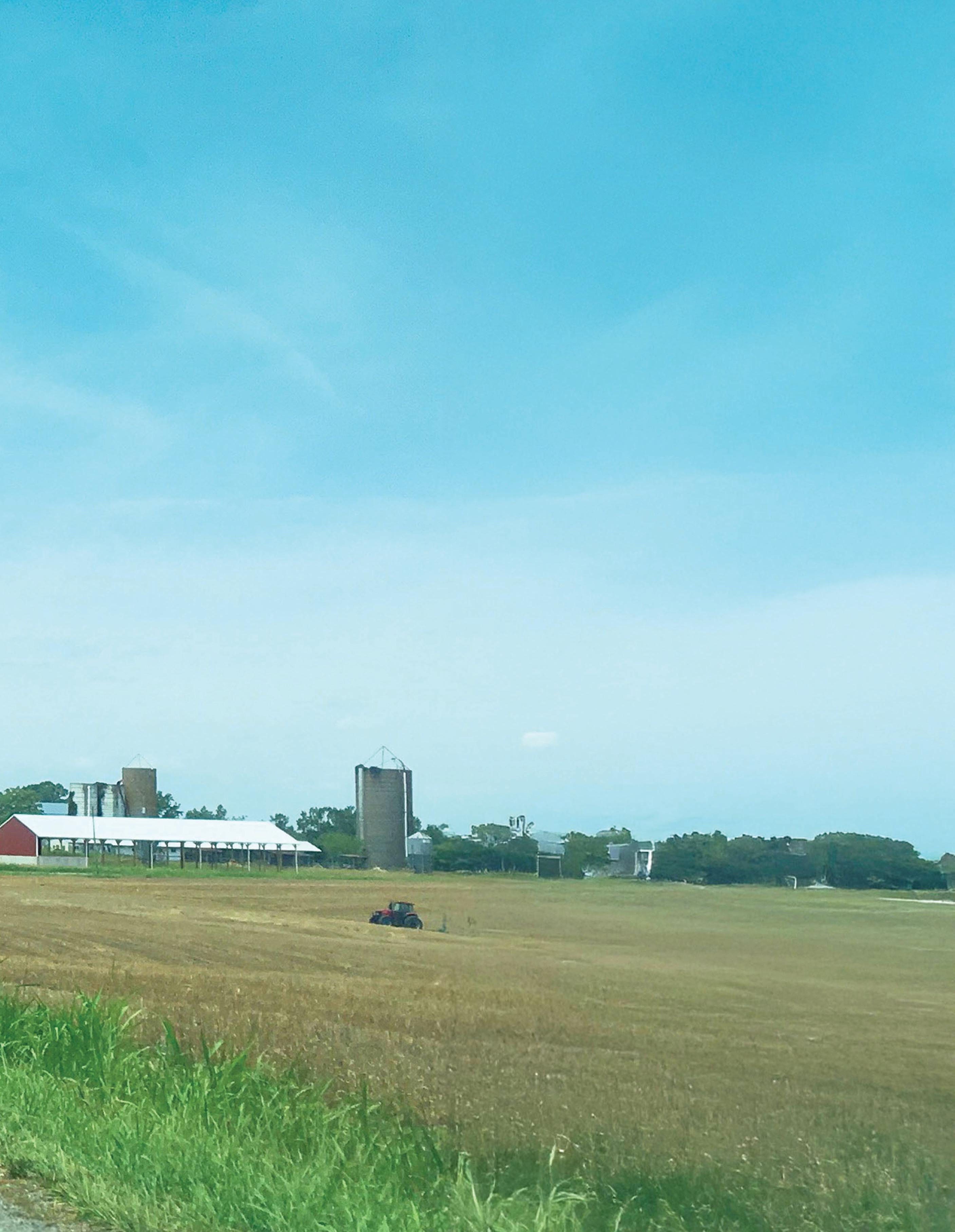
Spring through fall are busy times for farm equipment on the road
MARCH
• Disks, plows, cultivators
• Sprayers/applicators, manure spreaders
APRIL
• Disks, plows, cultivators
• Seed drills, planters
• Sprayers/applicators, manure spreaders
MAY
• Balers, hay wagons, flatbeds of haybales, mowers, rakes & tedders
• Combines, grain carts, trucks and grain trailers
• Disks, plows, cultivators
• Seed drills, planters
• Sprayers/applicators, manure spreaders
JUNE
• Balers, hay wagons, flatbeds of haybales, mowers, rakes & tedders
• Combines, grain carts, trucks and grain trailers
• Disks, plows, cultivators
• Harvesters, silage wagons and trucks
• Seed drills, planters
• Sprayers/applicators, manure spreaders
JULY
• Balers, hay wagons, flatbeds of haybales, mowers, rakes & tedders
• Harvesters, silage wagons and trucks
• Sprayers/applicators, manure spreaders
AUGUST
• Balers, hay wagons, flatbeds of haybales, mowers, rakes & tedders
• Harvesters, silage wagons and trucks
• Sprayers/applicators, manure spreaders
SEPTEMBER
• Balers, hay wagons, flatbeds of haybales, mowers, rakes & tedders
• Combines, grain carts, trucks and grain trailers
• Disks, plows, cultivators
• Harvesters, silage wagons and trucks
• Sprayers/applicators, manure spreaders
OCTOBER
• Combines, grain carts, trucks and grain trailers
• Disks, plows, cultivators
• Seed drills, planters
• Sprayers/applicators, manure spreaders
NOVEMBER
• Combines, grain carts, trucks and grain trailers
• Disks, plows, cultivators
• Seed drills, planters
• Sprayers/applicators, manure spreaders


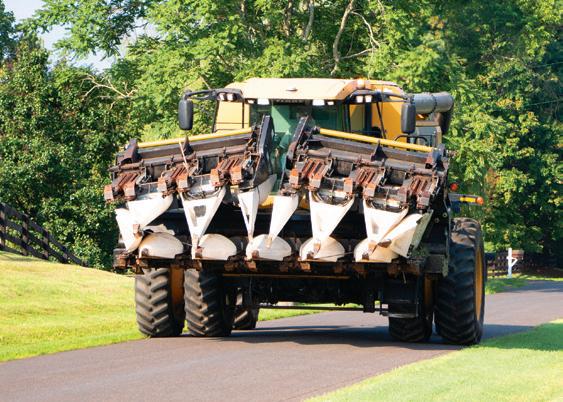
The Virginia Farm Bureau Farm Safety Program has started a new initiative—Safety Awareness for Farm Equipment on Roadways, or SAFER.


The initiative kicked off with a contest to raise awareness of slowmoving and large farm equipment on the roadways, and the potential dangers involved in transporting them.

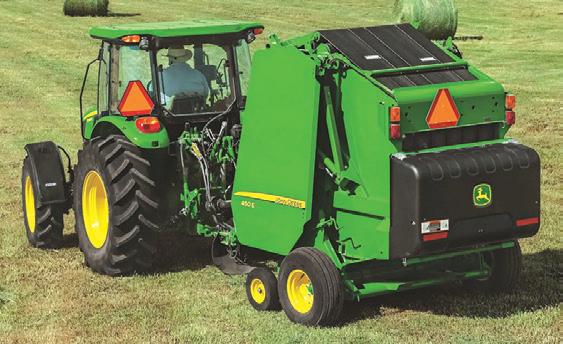
Community groups and civic and youth organizations are invited to create visual displays depicting the size difference between farm equipment and regular vehicles. The goal is to have displays in high-traffic public areas that will help make drivers more aware of farm equipment on the roadways.


There also is a category for educational campaigns that don’t involve a physical display, and a category for the most effective use of media channels to educate drivers about the presence of farm equipment on roadways.

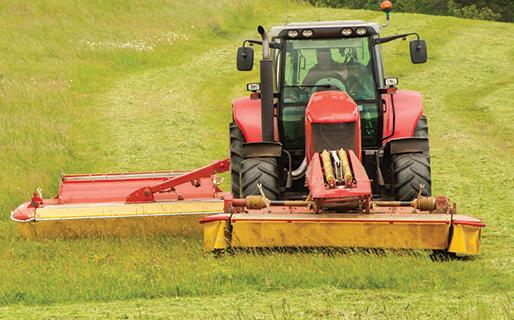
The contest runs through Oct. 31, and winners will be eligible for thousands of dollars in cash prizes. For details, visit vafb.com/Safety.

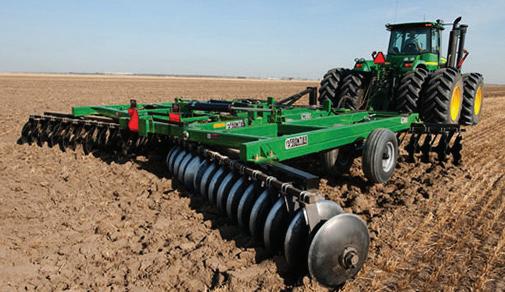






BY NICOLE ZEMA
Skim these numbers before we dunk into the details.
One Virginia dairy cow is milked about three times a day and produces an average 8 gallons of milk. Within 48 hours of farm collection, that milk is processed, packaged and delivered to hundreds of stores throughout Virginia and surrounding states.
A safe, streamlined supply chain keeps this nutritious staple flowing from the cow to your cereal in an impressive turnaround time. But Virginia dairy farmers have been refining the process for generations.
While shoppers can choose from an array of fluid-milk products today, dairy farmers likely selected robust bulls to sire their herds years ago.
The most productive dairy heifers are bred for desirable characteristics, including teat placement, length and uniformity. Meanwhile, farmers seek reproductive material from bulls with strong genetic profiles.
Artificial insemination optimizes herd heredity and keeps heifers safe from notoriously temperamental dairy bulls, said sixth-generation farmer Thomas French of Shenandoah County.
Dairy cows calve about once a year, gestating for nine months. They are bred about three months after calving and produce milk until a dry-off period, French said. “They get a vacation.”
A tanker arrives at French Brothers Dairy before dawn on alternating days. A hose passes through a hatch and connects to a bulk tank. About 17,000 pounds of cold fluid milk, or 2,000 gallons, is siphoned into the refrigerated tanker.
“A large farm may have two pickups a day,” said Eric Paulson, executive director of the Virginia State Dairymen’s Association. “There are seven processing plants in Virginia, and a fair portion of our milk also goes to North Carolina.” French Brothers recently celebrated
50 years with Maola Local Dairies, a farmer-owned cooperative based in Fairfax County. Maola markets and transports milk for French Brothers and 800 East Coast dairy families to its six processing plants.
Step 3: Inspection, processing and packaging
“Milk comes from the farm in a tanker, and leaves processing plants in packages,” Paulson explained. “A justin-time system gets it to store shelves through a process that’s been perfected over decades.”
Processing plants hold milk in large, refrigerated milk silos before it’s pasteurized and homogenized. Safe handling and inspections are overseen by Virginia Department of Health and Virginia Department of Agriculture and Consumer Services officials. They evaluate samples for bacterial counts or traces of antibiotics.
“It’s tested numerous times,” Paulson said. “Milk producers are proud to be part of a strictly regulated industry with high standards that helps consumers feel secure.”
Pasteurization is referred to as “a miracle of modern times,” he added. “But it’s a simple process—just heating milk to 161 degrees for 15 seconds and cooling it back down, which kills any bacteria and extends the shelf life.”
Homogenization breaks milk fat into smaller molecules, improving texture, taste and product consistency.
Plants often co-pack milk for both established labels and store brands.



Gallons of whole milk, buttermilk quarts and chocolate mini cartons were among the consumer products stacked in crates at Maola Local Dairies’ 8,200-square-foot distribution branch in Roanoke. Packaged shipments arrive from plants in bulk, and are sorted into orders for retail, institutions and restaurants.
Robby Lambert was hired as a route driver 15 years ago. Now he is director of Maola’s 10 distribution facilities in Virginia and North Carolina. Over 120 drivers make 9,000 deliveries weekly, while some major buyers like Food Lion arrange pickup.
Work is steady.
“The process from cow-to-customer is a continuous, 24-7 operation,” he said. “We keep it moving as quickly as possible since it’s a perishable product.”


Consumer choices were once limited to whole milk, 2%, 1% and skim.
“Today, the dairy industry has an incredible variety of products,” Paulson said.
Organic milk is now widely available. Other fluid milk products have been developed with an A2 protein that may improve digestibility.
“There also was a need for lactosefree milk in the marketplace, and the industry met it,” Paulson said. “A softfiltration process filters milk into base components that are put back together without the lactose. It’s still regular milk.”
Retailers don’t oversupply their milk inventories.
“Being a perishable product, you can’t store it long,” Paulson said. “Stores keep just enough supply until the next batch can be delivered.”
‘Virginia’s dairy belt’
Most Virginians once owned dairy cows to sustain their families. As populations grew, dairies operated within proximity to towns. Distribution was localized since fluid milk couldn’t be



Farm-fresh eggs come in many-colored shells, but the inside whites and yolks are the same.









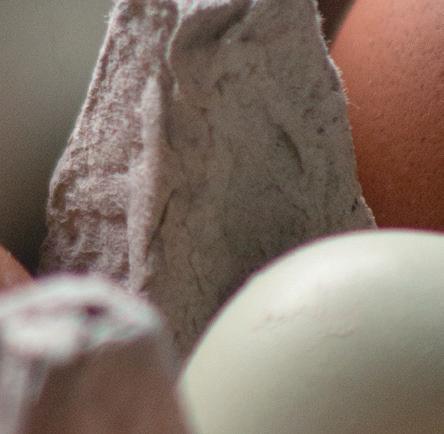








BY CHRISTINA AMANO DOLAN
There are many reasons why people acquire backyard chickens—for farm-fresh eggs, meat, compost, critter control or backyard entertainment.
Lori Clark’s journey began with nurturing chicken embryos alongside her students in the 4-H Embryology Program in Spotsylvania County. Clark is a Virginia Cooperative Extension 4-H youth development agent in Stafford County.
“Once those chicks hatched, I was in love—just like my third graders,” she recalled. “I was heartbroken to give them back.”
Determined to bring them home, Clark studied up. She reached out to her Extension colleagues, consulted a local farmer, and buried herself in instructional videos and “every book possible.”
She now cares for 12 hens on her half-acre plot in Spotsylvania, delighting neighbors and friends with delectable eggs.
While you don’t need a lot of experience or land to successfully raise a backyard flock, you do need one key ingredient:
“You’ve got to really love the process,” Clark laughed.
Egg laying “songs,” jailbreaks to the neighbors’ yard, and egg hunts around the property keep things interesting for Clark’s family.
Her hens sing like trumpets when dropping their eggs. Sometimes the amusing melody will come from unusual places—like the garage.
Along with some quirky habits, chickens come with a lot of needs.
“They need care seven days a week,” Clark noted. “You have to think about who’s going to watch them when you go on vacation.”
It’s also important to check:
• With your neighbors, as even hens tend to be fairly noisy. Roosters are not necessary for egg production.
• Local ordinances for any regulations on the number of hens and roosters
Recognize behaviors that may indicate illness or discomfort, including severe pecking or loss of appetite. Frequent squatting could be a sign that your hen is egg-bound, which means an egg is stuck in the oviduct, preventing the bird from laying it. To help pass the egg, Clark recommends soaking hens in water and Epsom salt within 24 hours.
Egg production slows over time and typically stops around seven years of age, so you may want to acquire more layers every few years. Avoid mixing newcomers with the flock right away.
The benefits of keeping backyard chickens can make the work worthwhile.
Next to beautifying her yard, Clark’s hens help alleviate stress.
“It’s so peaceful to do yard work while my chickens cling to me and make little cooing sounds,” she remarked.
Crowder most enjoys the enrichment they offer her young children.
“It’s good for them to see the whole aspects of farm life, and they love the chickens—especially the chicks,” she said.
Clark and Crowder recommend reaching out to your local Virginia Cooperative Extension office for guidance on keeping backyard birds.
Search pubs.ext.vt.edu for more information.
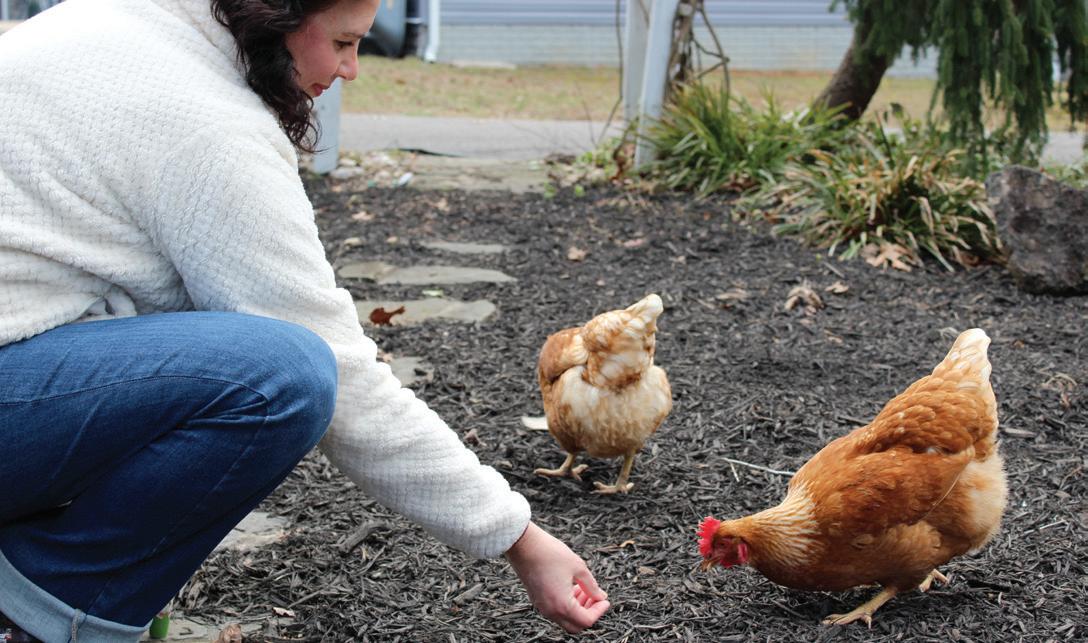


Backyard flocks are susceptible to avian flu, so the U.S. Department of Agriculture recommends that owners take the following steps to prevent it:
Restrict access to your property and your birds. Disinfect your clothes, shoes, equipment and hands.
If you have been near other birds or bird owners, clean and disinfect poultry cages and equipment before going home.
Don’t borrow lawn and garden equipment, tools or poultry supplies from other bird owners.
Know the warning signs of avian flu like sudden increase in bird deaths, sneezing, coughing, nasal discharge, watery or green diarrhea, lack of energy, poor appetite, drop in egg production, swelling around the eyes, neck and head, and purple discoloration of wattles, combs and legs.
Report sick birds or unusual bird deaths to the state veterinarian’s office at 804-692-0601 or vastatevet@vdacs.virginia.gov.








BY ALICE KEMP
Mental health is steadily moving out of the shadows and into mainstream dialogue.
With May designated as Mental Health Awareness Month, it’s an opportunity to recognize mental wellbeing as a critical component of overall health while breaking stigma and sparking conversations.
“More people are being open about their struggles and journeys,” said Tracy Cornatzer, director of sales for VAFB Health Insurance Solutions. “And when more people talk about it, they’re connecting with others, which can lead to finding more help.”
Part of that support comes from expanded insurance benefits. To address the growing need for mental health care, insurers are increasingly broadening coverage to make therapy, counseling, family support services and psychiatric care more accessible than ever.
Although insurance companies are legally required to provide mental health benefits to their insureds, some are going farther. Companies like Anthem Blue Cross and Blue Shield are expanding networks and partnering with more providers. They also are offering convenient options like telehealth, in-home appointments, flexible scheduling, customized treatment plans and reduced waitlists.
“If you’re in rural Virginia, the nearest provider might be many miles away,” shared Howard Dillon, Anthem’s director of strategy programs and sales. “A virtual option is something that gets you care right away—you’re not having to wait and drive.”
And expanding access is more important than ever. The National Alliance on Mental Illness reports that 1 in 5 adults—57.8 million people—experience mental illness each year, and 17% of youth ages 6-17 face a mental health disorder.
“I think the COVID-19 pandemic really brought it to the forefront,” said Steve Jenson, co-founder of Aspire365, a
If you or someone you know is struggling or in crisis, help is available. Call or text 988 or chat online at 988lifeline.org
Your primary care doctor and health insurance company can recommend sources for professional help. To find out more about mental health benefits and coverage options, check with your insurance carrier and mental health care provider.
Additionally, The Virginia Department of Behavioral Health and Development Services’ community services boards also can connect individuals and families with mental health care based on location. Visit bit.ly/3Q9CgJu
comprehensive behavioral health solutions provider and Anthem partner.
He noted that while the pandemic helped normalize mental health discussions, it also intensified the mental health crisis, highlighting the need for accessible, affordable, high-quality care.
“This is really at the next level of getting the right care to the right people at the right time, and in the right setting.”
Recognizing the deep connection between mental and physical health, insurers are embracing a ‘whole health’ approach—integrating medical, prescription drug, dental, vision, life, disability and behavioral benefits.
According to the Centers for Disease Control and Prevention, mental health conditions like depression increase the risk for chronic physical conditions like diabetes, heart disease and stroke. And nearly one in three people with a long-term physical health condition also experiences a mental health issue.
Mental health is no longer an afterthought, Jenson said. Insurers and providers are increasingly adopting integrated approaches.
Aspire365, for example, offers holistic models—addressing mental health alongside physical wellness initiatives like dietary, fitness and lifestyle coaching. Individuals also can complete a preventive behavioral health checkup to assess mental health needs.
“It’s preventive care just like your annual physical or dental checkup,” Jenson said. “The idea is to build mental health into your annual health checkup routine.”
He added that “getting people good mental health care helps them physically. People are realizing that our behavioral health, our mental health, is a key component of overall health. It’s all tied together.”

If a grandparent gifts a vehicle to a grandchild and the title is transferred, the grandchild needs to get their own insurance policy.
Just as life changes, so do your insurable interests. What you insure today might not be what you needed yesterday, and it may change again tomorrow.
Insurable interests exist when a person has a financial stake in the ownership of property, meaning any loss or damage would cause financial hardship or other losses. Whether through purchases, inheritance or changing circumstances, it’s essential to review your coverage to ensure your policies reflect your current situation.
“Insurable interests occur when a person derives a financial or other benefit from the continuous existence of property without impairment or damage to the insured object,” explained Lisa Whitus, Virginia Farm Bureau Mutual Insurance Co. commercial lines underwriting manager. “Normally, these interests are established by ownership, possession or direct relationship.”
While homes and vehicles are common insurable interests, “there are a billion examples,” Whitus said.
Valuables like musical instruments, antiques, jewelry, family heirlooms and prized collections also qualify as insurable interests. Additionally, an endorsement or separate policy may be needed for high-value items. If someone bought a new lawnmower costing several thousand dollars, its value may exceed what’s covered under a homeowner’s policy.
“If we’re talking about a piece of property or home, whose name is on the deed? If it’s a vehicle, whose name is on the title?” said Ben Ashby,
VFBMIC personal lines underwriting manager.
When property is purchased, sold or acquired as a gift through death or other circumstances, it’s important that the new owner is the insured party on the property—and it’s up to the owner to secure their coverage. People cannot insure property they don’t own or have a financial interest in.
For example, if a grandfather gifts a car to a granddaughter and the title is transferred, she must obtain her own auto insurance policy. As the titled owner, the granddaughter suffers financial loss should the car be damaged and would be unable to make a claim using her grandfather’s policy.
“The name on the insured policy should match the name on the title or deed—that’s who we are bound to,” Ashby said. “It can affect every angle of policy if it’s not done correctly.”
Failing to update policies can lead coverage gaps, or having insurance on something you might not even own—potentially creating liability issues.
It’s also important to keep copies of deeds, titles and important paperwork to verify insurable interests if a dispute arises.
To check if your insurable interests are covered under any scenario, your Farm Bureau insurance agent can help identify any potential gaps in coverage on valuable property.
“Our agents know these people, their community, and they should take the time to really get a clear picture of who has insurable interests and make sure they’re insured correctly,” Ashby said.
INGREDIENTS
1 pound pork belly
2 tablespoons Chinese five-spice powder
1 teaspoon kosher salt
2 tablespoons canola oil
2 cups beef broth
¼ cup soy sauce
¼ cup brown sugar
2 tablespoons chopped ginger
2 tablespoons olive oil
watermelon, cut into 15 1”x3” pieces
15 4½” flour tortillas, warmed
1 lime, cut into wedges
DIRECTIONS
Heat oven to 325°.
Rub the pork belly with the five-spice powder and salt, and let rest at room temperature for 20 minutes.
In a sauté pan, heat the canola oil on medium-high heat. Brown the pork belly on all sides, and then transfer to an ovensafe dish. Pour in the broth, soy sauce, sugar and ginger, cover with foil, and transfer to the oven to braise for 2 hours and 30 minutes.
Remove from the oven, and let cool in the liquid for one hour. Remove the pork belly from the liquid, and cool in the refrigerator for three hours. Cut the meat into 1” x 3” pieces.
In a large sauté pan, heat the olive oil over medium-high heat. Add the pork belly, and cook until crispy and heated through.
Place pieces of watermelon and pork belly in each tortilla, and add a squeeze of fresh lime juice.
—Recipe courtesy of Chef Tammy Brawley on Real Virginia, Virginia Farm Bureau’s weekly television program

Scan the QR code to watch Chef Tammy Brawley make this recipe.

CITRUS SLAW
2 tablespoons seasoned rice vinegar
2 tablespoons canola oil
½ cup vertically sliced red onion
1 cup thinly sliced red bell pepper
1 cup diced orange sections
2 cups prepared coleslaw mix
TACO FILLING
1 tablespoon creole seasoning
1 tablespoon cumin
1 tablespoon garlic powder
1 tablespoon onion powder
1 tablespoon canola oil
1 tablespoon fresh lemon or lime juice
4 6-ounce catfish fillets
4 soft tortillas
lime wedges
cilantro leaves, optional
DIRECTIONS
Prepare the citrus slaw by mixing all the ingredients in a bowl and tossing gently. Cover and chill.
Heat oven to 450°.
In a small bowl, combine the dry seasonings, oil and lemon or lime juice. Brush the mixture over both sides of the fillets, and arrange them on a baking sheet coated with cooking spray.
Bake 6-8 minutes on each side, until the fish flakes easily with a fork.
Slice the fillets and then place a portion of fish on each tortilla and top with the slaw. Squeeze the lime over the slaw and garnish with cilantro, if using.
—Recipe adapted from Virginia Cooperative Extension, Virginia State University
INGREDIENTS
2 teaspoons cooking oil
1 small onion, chopped
2 cups refried beans
8 hard taco shells or soft tortillas
¼ head of iceburg lettuce, chopped
2 medium tomatoes, chopped
1 cup shredded cheddar cheese
taco sauce or salsa
Heat the oil in a skillet over medium heat, add onion and cook until soft. Add the refried beans to the skillet, and heat thoroughly.
Spread refried bean mixture in taco shells or on tortillas. Sprinkle with shredded cheese, lettuce, chopped tomatoes, and taco sauce or salsa, as desired.
—Recipe adapted from University of Wisconsin Cooperative Extension Service


Selling insurance can be an extremely emotional job.
About 30 years ago, just five days before Christmas, Wesley Harris got a call about 9 p.m. on a Sunday.
One of his client families had attended a Sunday evening church program, and when they returned several hours later, found their home burned to the ground.
“I got up, put on my Farm Bureau insurance agent face and went to meet them,” Harris recalled. “I hugged them and held them and told them that we would take care of them.”
The next day he contacted the home office, which sent an advance check so the family could replace the Christmas gifts that burned in the fire.
“I will always remember that day,” said Harris, who was a Charlotte County insurance agent then.
Today, Harris is an agency manager in Campbell County and a 43-year Virginia Farm Bureau Mutual Insurance Co. veteran. He received the company’s 2024 Ralph Stokes Career Achievement Award at this year’s VFBMIC Sales Conference.
“I’m no Ralph Stokes, because he gave it his all while being disabled,” Harris humbly remarked. “But I have tried to work with the same honesty, integrity and willingness to help people as Ralph Stokes did.”
Harris is no stranger to Farm Bureau accolades. He’s been named Master Agent a dozen times and State Agent of the Year multiple times, and he has won all the company’s other sales competitions.
He said his success stems from his philosophy of trying every day to be better than the day before. That’s also advice that he shares with the many agents he’s mentored over the years.
Bart Mitchell, last year’s Ralph Stokes honoree, is one of them.
“Wesley was like an older sibling to me when I started with Farm Bureau and has been a great role model for me during my entire career,” shared Mitchell, who presented the award to
2023 Bart Mitchell, Goochland County
2022 Amanda Compton, Bedford County
2021 Jason Seward, Surry County
2020 Ed Terry, Floyd County
2019 Ed Sale, Amherst County
2018 Jim Jervey, Southampton County
2017 Chris Adams, Hanover County
2016 Mike Mullins, Washington County
2015 Debbie Murphy, Hanover County
2014 Jerry Funkhouser, Shenandoah County
2013 Robin Gloss, Campbell County
Harris. Mitchell met Harris when he was 14.
At the time, Harris was working as a plant manager for Burlington Industries and farming part-time. He had been growing hay for Bart’s father, Bert Mitchell, who recommended Harris for a job as an agent in Charlotte County. “Bert is ike a second father to me, and Bart is like a second son,” Harris explained.
“Over the years, and even today, Wesley serves a mentor for many agents across the state reinforcing the opportunities our company provides us and coaching them through the challenges of this job,” Mitchell said. “He has spent the majority of his adult life committed to supporting our organization and serving the needs of our members.”
Harris said everything he does is about selling a service and a promise to pay for what his clients purchase. “If you live up to your promises, you’ll never be without customers.”
He’s also excelled as a bass fisherman, winning hundreds of thousands of dollars, as well as trucks and boats. As a member of Major League Fishing, the world’s largest tournament-fishing organization, Harris has participated in 99 MLF events and placed in the Top 10 over a dozen times.
He even found a way to use fishing to increase Farm Bureau business. About 12 years ago he wrapped his boat with the VFBMIC logo and kept it on for two years.
Harris also has found a way to use fishing for good. Competing and winning fishing tournaments helped him pay for his son Chad’s education at the University of Richmond.
It also has enabled him to contribute to the Wounded Warriors Project. Several times each year, he and about 100 of his fellow fishermen take veterans who are Wounded Warrior alumni out on their boats for a fishing tournament. Harris said he has great respect for veterans, and hosting a fishing tournament is a way to honor them.

Virginia Farm Bureau Mutual Insurance Co. customers can enroll their policies in the company’s paperless option for quick, easy access to insurance documents and policy information.
Paperless enrollees have around-the-clock access to policy documents and statements. Additionally, they can pay their bills online, review important documents and receive email alerts when new documents become available.
Paperless services are available on most VFBMIC products across all lines of business.
Policyholders can enroll in the paperless option by logging in to their account on vafb.com/memberlogin. Customers who don’t have an online account may register at vafb.com/ membership-at-work/membership/join-now
Once logged in, eligible policies for paperless will be listed, and customers can choose which policies to enroll. Customers also can enroll their policies by calling their county Farm Bureau office.

